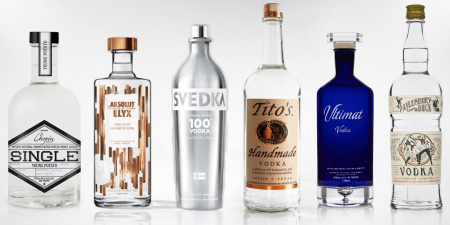With so many options available, different kinds of alcoholic drinks can be confusing especially when you are not an alcohol aficionado. In fact, some people may not know how to tell whiskey from vodka although they are obviously two different alcohol beverages. If you are one of those people, this article is for you. This article will discuss the difference between whiskey and vodka.
Summary Table
| Whiskey | Vodka |
| Alcoholic drink produced from different kinds of grains like wheat, rye, corn, or barley | Alcoholic drink that typically consists of water and rectified ethanol; made from starch-containing sources like beets, potatoes, grains, fruits, or sugar |
| Taste may range from light to thick; color may range from light gold to dark amber; aroma is powerful | Odorless, flavorless, and colorless; some brands may add artificial flavorings like chocolate, vanilla, pepper, etc. |
| Aged in charred oak barrels | Unaged |
| May contain 40% to 60% alcohol | Alcohol level starts at 37% to 40% |
| Not easy to drink; served with no other ingredients mixed; to be slowly consumed by “serious” drinkers, liquor enthusiasts, or people engaged in slow-paced conversations | Easy to drink; can be served “neat” or mixed with other ingredients in a cocktail; for casual and social events |
Descriptions

Whiskey or “whisky” is an alcoholic drink produced from different kinds of grains like wheat, rye, corn, or barley. The process involves sprouting, fermenting, distilling, and aging the mixture in charred oak barrels. Whiskey may contain 40% to 60% alcohol. Its color can range from light gold to dark amber and it may have a light flavor or thick flavor depending on its age. Different types of whiskey are available depending on the type of grain used: corn whiskey, rye whiskey, wheat whiskey, rye malt whiskey, and more.
It is best if served on its own in special glasses.

Vodka is a colorless, tasteless, odorless alcoholic beverage that typically consists of water and rectified ethanol. It is made from any starch-containing sources like beets, potatoes, grains, fruits, or plain sugar.
Vodka production is not covered by strict laws. In general, the process involves fermentation, distillation, and filtration. It does not go through aging and is bottled after filtration. In the United States, vodka has a minimum alcohol level of 40%.
In Europe, the minimum alcohol level is 37.5%.
Although vodka is known to be “flavorless,” some brands may inject additives like artificial flavorings to the product. Some of the available flavors are chocolate, vanilla, fruit, and pepper. These enhance the taste and add a pleasant aroma to the drink.
Vodka is great for casual and social events.
It can be served “neat” or “pure,” which means it is served as is and not mixed with anything. In the U.S and other parts of Europe, vodka is famous as a cocktail ingredient.
Whiskey vs Vodka
What, then, is the difference between whiskey and vodka?
Whiskey is made from various types of grains, while vodka is produced from any raw material that contains starch. Whiskey undergoes an aging process, while vodka does not. Whiskey may contain 40% to 60% alcohol, while vodka has a minimum of 37% to 40% alcohol.
When it comes to appearance, whiskey may be light gold or dark amber, while vodka is colorless like water.
Whiskey may taste light or heavy depending on its age, while vodka is flavorless although some brands add artificial flavor to their product. Whiskey has a powerful aroma, while vodka is odorless.
Whiskey is served “pure” and is perfect for serious drinkers, liquor enthusiasts, or those who are engaged in private and slow-paced conversations. Vodka can be served “neat” and can also be mixed with other ingredients in a cocktail.





